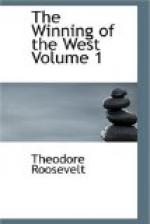For a time in the early part of 1774 there seemed quite as much likelihood of the Virginians being drawn into a fight with the Pennsylvanians as with the Shawnees. While the Pennsylvanian commissioners were trying to come to an agreement concerning the boundaries with Lord Dunmore, the representatives of the two contesting parties at Fort Pitt were on the verge of actual collision. The Earl’s agent in the disputed territory was a Captain John Conolly,[3] a man of violent temper and bad character. He embodied the men favorable to his side as a sort of Virginian militia, with which he not only menaced both hostile and friendly Indians, but the adherents of the Pennsylvanian government as well. He destroyed their houses, killed their cattle and hogs, impressed their horses, and finally so angered them that they threatened to take refuge in the stockade at Fort Pitt, and defy him to open war,—although even in the midst of these quarrels with Conolly their loyalty to the Quaker State was somewhat doubtful.[4]
The Virginians were the only foes the western Indians really dreaded; for their backwoodsmen were of warlike temper, and had learned to fight effectively in the forest. The Indians styled them Long Knives; or, to be more exact, they called them collectively the “Big Knife."[5] There have been many accounts given of the origin of this name, some ascribing it to the long knives worn by the hunters and backwoodsmen generally, others to the fact that some of the noted Virginian fighters in their early skirmishes were armed with swords. At any rate the title was accepted by all the Indians as applying to their most determined foes among the colonists; and finally, after we had become a nation, was extended so as to apply to Americans generally.
The war that now ensued was not general. The Six Nations, as a whole, took no part in it, while Pennsylvania also stood aloof; indeed at one time it was proposed that the Pennsylvanians and Iroquois should jointly endeavor to mediate between the combatants.[6] The struggle was purely between the Virginians and the northwestern Indians.
The interests of the Virginians and Pennsylvanians conflicted not only in respect to the ownership of the land, but also in respect to the policy to be pursued regarding the Indians. The former were armed colonists, whose interest it was to get actual possession of the soil;[7] whereas in Pennsylvania the Indian trade was very important and lucrative, and the numerous traders to the Indian towns were anxious that the redskins should remain in undisturbed enjoyment of their forests, and that no white man should be allowed to come among them; moreover, so long as they were able to make heavy profits, they were utterly indifferent to the well-being of the white frontiersmen, and in return incurred the suspicion and hatred of the latter. The Virginians accused the traders of being the main cause of the difficulty,[8] asserting that they sometimes incited the Indians to outrages,




